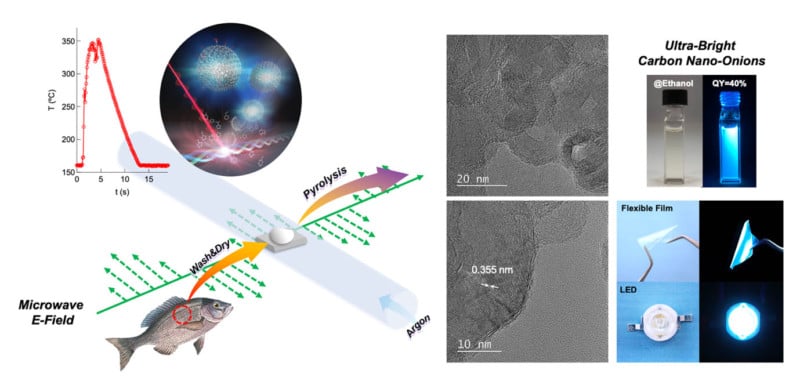Scientists Develop a More Efficient LED Made from Fish Scales
![]()
Scientists from the Nagoya Institute of Technology (NITech) have developed a simple, fast, and energy-efficient method to create a carbon nanostructure made from fish scales that results in a vastly more efficient LED.
The team, which includes Assistant Professor Yunzi Xin, Master’s student Kai Odachi, and Associate Professor Takashi Shirai, has synthesized what are known as carbon nano-onions (CNOs) from fish scales, a form of carbon nanostructure that has excellent electrical and thermal conductivity. CNOs are nanostructures composed of concentric shells of fullerenes, resembling cages within cages. They offer multiple attractive qualities such as a high surface area and large electrical and thermal conductivities.
CNOs are currently found in several applications in biomedicine, bioimaging, energy conversion, and electronics, but the current method to produce them is highly complex, consumes a lot of energy, and is in some cases toxic.
The NITech researchers have developed a synthesis route in which fish scales extracted from fish waste after cleaning are converted into CNOs in seconds.
Somewhat amusingly, the team isn’t quite sure why fish scales are able to be converted into CNOs so easily. While the exact reason isn’t clear, the team believes it has to do with the collagen contained in the scales which can absorb enough microwave radiation to produce a fast rise in temperature.
“This leads to thermal decomposition or ‘pyrolysis,’ which produces certain gases that support the assembly of CNOs,” the team explains. “What is remarkable about this approach is that it needs no complex catalysts, nor harsh conditions, nor prolonged wait times; the fish scales can be converted into CNOs in less than 10 seconds!”
The result is not only faster and eco-friendly but also results in a better CNO. The process yields a CNO with what the scientists describe as “very high crystallinity” which provides exceptional optical properties.

“The CNOs exhibit ultra-bright visible-light emission with an efficiency (or quantum yield) of 40%,” Dr. Shirai says. “This value, which has never been achieved before, is about 10 times higher than that of previously reported CNOs synthesized via conventional methods.”
This breakthrough in particular affects LEDs, and the team demonstrated their practical application there using blue-light-emitting thin films.
“The stable optical properties could enable us to fabricate large-area emissive flexible films and LED devices,” Dr. Shirai continues. “These findings will open up new avenues for the development of next-generation displays and solid-state lighting.”
The team’s full research paper has been published in Green Chemistry.
Image credits: Takashi Shirai from NITech, Japan.